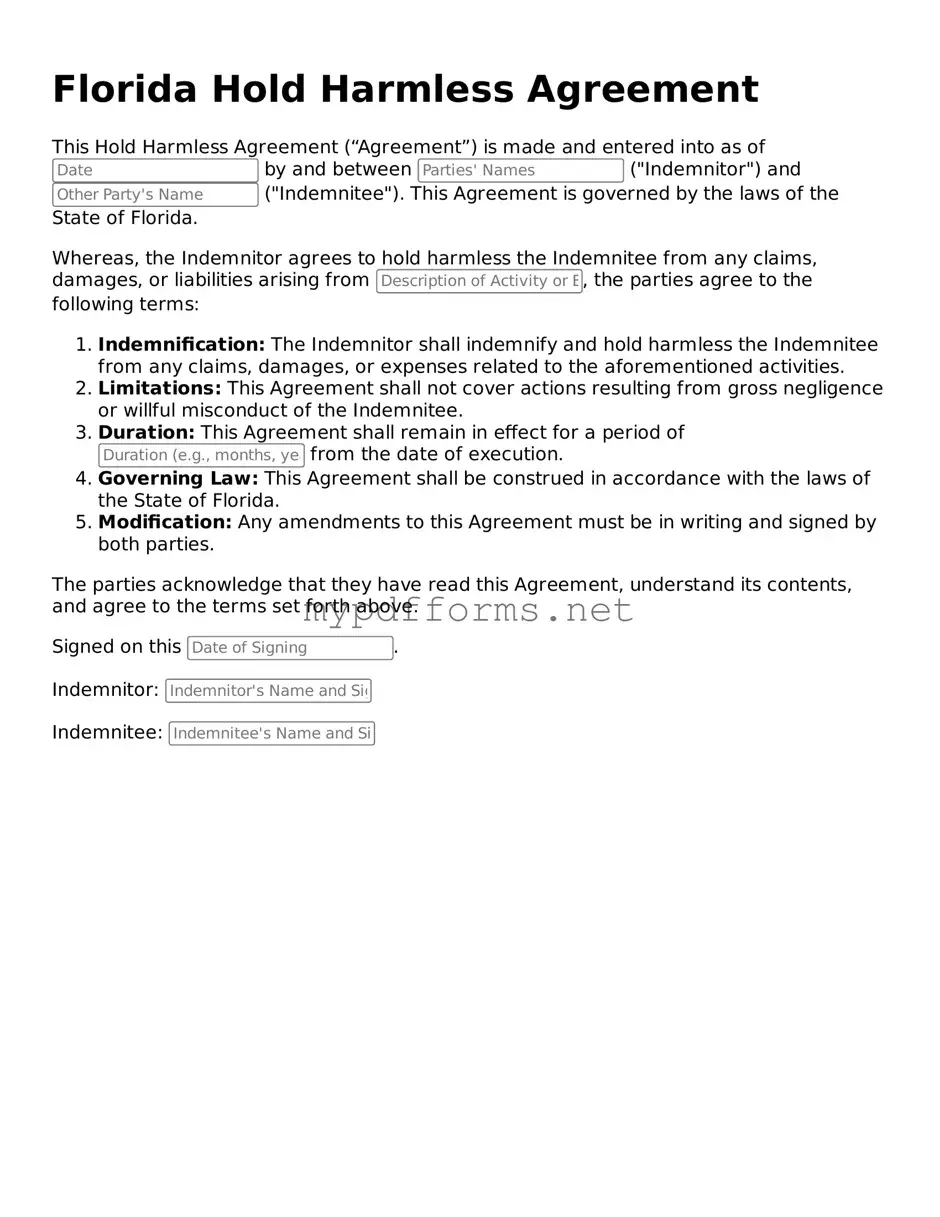The Florida Hold Harmless Agreement is quite similar to a Liability Waiver. Both documents serve to protect one party from legal responsibility for injuries or damages that may occur during an activity. In a Liability Waiver, participants acknowledge the risks involved and agree not to hold the organizer accountable for any incidents. This is commonly used in recreational activities, sports events, or any situation where there is a potential for injury, ensuring that participants are aware of the risks they are taking.
Another document that shares similarities is the Indemnity Agreement. This agreement is designed to protect one party by requiring another to compensate for any losses or damages incurred. While a Hold Harmless Agreement typically focuses on shielding one party from liability, an Indemnity Agreement can involve reimbursement for costs related to claims or lawsuits. Both documents emphasize the importance of understanding responsibilities and risks associated with certain activities or agreements.
The Release of Liability form is also akin to the Hold Harmless Agreement. This document is often used in situations where individuals participate in activities that could potentially lead to injury. By signing a Release of Liability, participants agree not to sue the organizer for any injuries sustained during the activity. This form is particularly common in adventure sports, where the risks are well-known, and participants voluntarily assume those risks.
Similar to these, the Participant Agreement serves to outline the responsibilities and risks involved in an event or activity. This document often includes a Hold Harmless clause, ensuring that participants acknowledge and accept the inherent risks. By signing, participants agree to take responsibility for their actions, reducing the liability of the event organizers or hosts.
The Safety Agreement is another document that aligns with the Hold Harmless Agreement. This type of agreement focuses on ensuring that all parties involved understand the safety protocols and procedures in place. By agreeing to the terms, participants acknowledge their understanding of the risks and agree to follow safety guidelines, which helps to minimize liability for the organizers.
A Facility Use Agreement can also be similar, especially when it includes a Hold Harmless clause. This document is typically used when one party wishes to use another's property for an event or activity. By signing the agreement, the user agrees to indemnify the property owner against any claims arising from the use of the facility, thus protecting the owner from potential legal issues.
For those involved in forming an LLC in Illinois, understanding the importance of legal agreements is essential, and a foundational document is the Operating Agreement. This particular agreement ensures clarity and structure in a business's governance, much like the considerations for risk management found in other agreements. If you're seeking resources to assist with your operations, you can explore Illinois Forms to find templates and guidance tailored to your needs.
The Contractor Agreement may also bear resemblance to the Hold Harmless Agreement, particularly when it includes indemnification provisions. Contractors often agree to hold clients harmless from claims arising from their work. This ensures that if any issues arise due to the contractor's actions, they are responsible for any resulting claims or damages, thereby protecting the client.
The Non-Disclosure Agreement (NDA) can also share similarities in terms of protecting one party's interests. While an NDA primarily focuses on confidentiality, it may include clauses that limit liability for disclosures made in good faith. Both documents emphasize the importance of understanding and accepting certain risks, whether related to confidentiality or physical activities.
Lastly, the Insurance Waiver is akin to the Hold Harmless Agreement. This document requires individuals to waive their right to make claims against an insurance policy for certain risks. By signing, individuals acknowledge that they understand the risks and agree not to seek compensation from the insurance provider. This can be particularly relevant in high-risk activities where insurance coverage may be limited.
